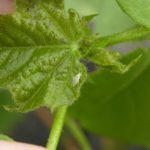Cotton fields range from 2-3 leaf to 11-12 leaf. Many fields have squares with the older fields at or a little beyond Matchhead square.
Fields of squaring cotton should be scouted 1-2 times per week for cotton fleahoppers. The cotton fleahopper can cause yield losses and delayed maturity by feeding on young squares, causing them to fall off the plant. Smaller squares are more sensitive to fleahopper feeding. Once a square is 1/4 inch in width, it is thought to be safe from the cotton fleahopper. Fields are susceptible to fleahoppers into the first week of bloom. Most entomologist consider the crop safe after bloom, but this is a debated issue. More often, the cotton fleahopper numbers drop off once the crop begins to bloom.
Last week’s post discussed the cotton fleahopper in more depth. Read more HERE
I found some cotton aphids on a field this week. This is not an insect problem in this field right now. The aphids were only on a few plants and crop maturity was 5-6 leaf.
If you find aphids, determine what percentage of plants have high numbers of aphids. An economic threshold for aphids is 50-100 per leaf on plants across the field during boll fill. If you find aphids above this threshold, wait a 3-4 days and return to the infested areas to see if the aphids have increased or decreased. Cotton aphids are rarely an economic pest in cotton before bloom. Often, the aphid numbers decline rapidly after a few days.
You should also look for lady beetles, syrphid fly larvae, lacewing larvae, and aphid mummies, the golden-brown swollen aphid bodies which are parasitized by a small wasp. Lady beetles, syrphid larvae and lacewing larvae can eat a lot of aphids per day. As few as 10% aphid mummies on the leaf indicate a population in decline from parasitization.
Crop Scouting Meeting
When: 9 am, Monday, April 24
Where: FM 1679, just south of Sanders Rd.
Topics discussed will include scouting techniques and PGRs in cotton.
